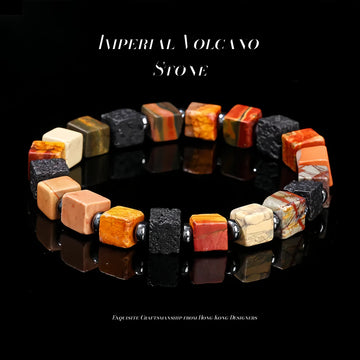As a traditional accessory, when wearing a stone bracelet, it is necessary to ensure that the size is appropriate to balance comfort and aesthetics. For bracelets of different materials and structures, the following adjustment methods can be adopted:
First, open-type stone bracelets
Features: There are openings at both ends, and the ring diameter can be changed by adjusting the size of the openings.
Adjustment method:
Manual adjustment
Hold both ends of the bracelet with both hands, gently pull it apart to the sides or push it inward, and adjust it to a size suitable for the wrist.
Note: The force should be uniform to avoid breakage caused by unilateral force.
Use the adjustment tool:
If the bracelet is thick or made of hard material, you can wrap both ends with soft cloth and use wooden or plastic tools to assist in adjustment.
Second, the loose-fitting stone bracelet
Features: Both ends are connected by movable clips or chains, and the size can be flexibly adjusted.
Adjustment method:
Chain adjustment
Loosen the chain lock, increase or decrease the chain length according to the size of your wrist, and then re-fasten it.
Buckle adjustment
Find the adjustment hole of the buckle, insert one end into the appropriate hole, and make sure it is worn stably.
Third, closed-mouth stone bracelets
Features: No opening, fixed size, and needs to be adapted to the wrist through other means.
Adjustment method:
Select elastic material:
Give priority to choosing bracelets made of rubber, silicone or elastic metal to adapt to the thickness of the wrist with elasticity.
With the help of lubricants:
Apply a small amount of hand cream or soapy water to your wrist to reduce friction and make it easier to wear and remove.
Temporary adjustment (not recommended for long-term use)
Wrap a thin string or rubber band around the inner side of the bracelet to temporarily reduce the diameter of the loop, but it may damage the bracelet or affect its appearance.
Fourth, precautions for special material stone bracelets
Jade/crystal bracelet
Avoid violent adjustment. It is recommended to choose an open or elastic design to prevent cracks or fractures.
Wooden bracelet
It is prone to deformation when exposed to water. After adjustment, it should be kept dry and frequent adjustments should be avoided.
Metal stone bracelet
When adjusting, pay attention to whether the gemstone is loose to avoid dropping it due to bumps.
Fifth, daily wearing suggestions
Measure the wrist size:
Use a soft tape measure or a thin string to wrap around the thickest part of your wrist once. After measurement, add 1-2cm as a reference for the size of the bracelet.
Trial wear confirmation:
Try it on before purchasing to ensure that the bracelet can slide smoothly through the wrist joint and is neither too loose nor too tight after wearing.
Regular inspection
Open and hinged bracelets need to be checked regularly for loose connections to prevent them from falling off.
By using the above methods, you can choose the appropriate adjustment method according to the type and material of the bracelet to ensure comfortable and safe wearing.







